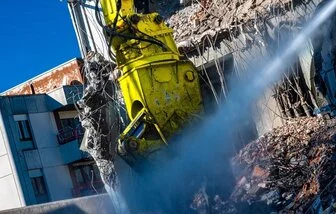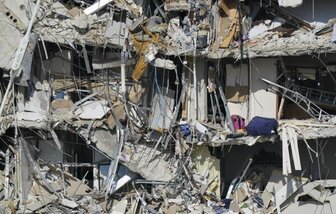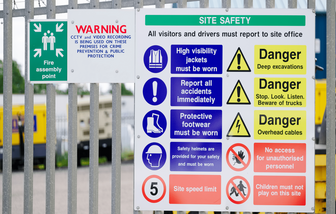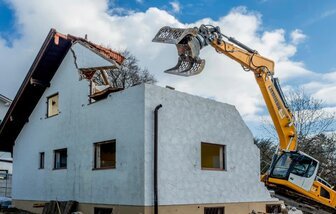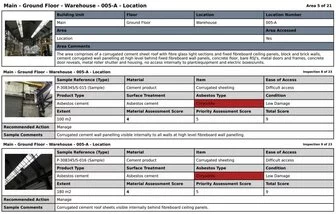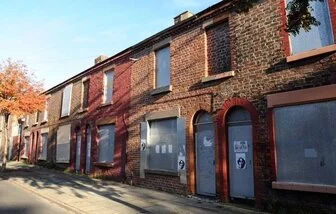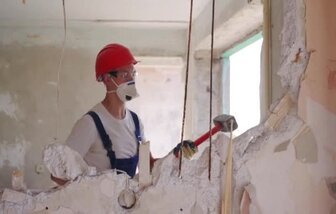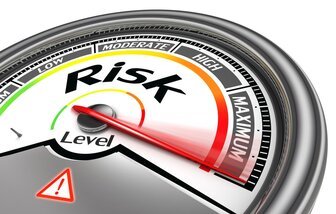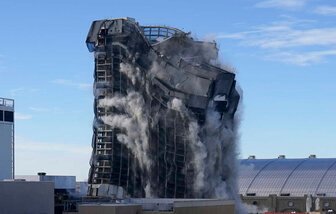High risk demolition
High risk demolition overview
Demolition, though necessary is a dangerous part of building construction. It comes with many health and safety risks that need to be addressed for the welfare of the project and crew.
In construction demolition, there is a difference between hazard and risk and both are equally important.
A hazard is something such as an object that can cause harm. A risk is the chance that the object will cause harm.
The building contractor needs to make a thorough risk assessment to look for both risks and hazards. Control measures are then implemented to prevent any accident that could be fatal. Hazards cannot be avoided but the risks that they pose can be prevented.
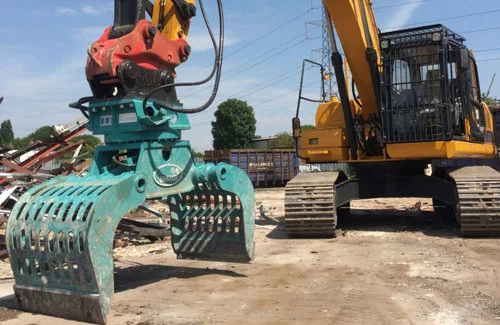
Demolition is necessary when a weak part of a building needs to be demolished for renovation. It could include both commercial and residential projects such as interior demolition. Demolition involves shifting heavy loads and machinery up a height. It involves using explosives and heavy duty equipment. In the construction industry, demolition services are used for demolishing a building or site work service. Demolition contractors even manage a project site for demolition of construction rubbish, rubble, debris and waste material.
A hazard can be any physical object or entity such as heavy machinery, pipelines, gas, and the building itself. These have the potential to cause harm such as injuries and disease. It can be weather, toxins, and biochemical waste. Despite precautionary measures, they can still pose as risks. A risk is the chance that these dangerous objects can cause physical injury to crews.
They can endanger the health of the demolition staff. Many hazards in construction and demolition are unavoidable. You need the machinery. The damaged building will need demolishing. You cannot avoid it. You need to neutralise the health risks that arise from such hazards during the demolition operation.
Manual demolition– This too includes the risks of falling objects and demolished walls. It includes manual handling of equipment and exposure to dust and noise. Manual demolition includes the use of explosives that are a high-risk hazard. Untrained handling of explosives can cause fatalities.
Manual roof demolition: This poses a risk of cave-ins that can cause the fall of workers. Roofs include chimneys and spires which need to be demolished by hand. This makes them high-risk objects.
Manual floor demolition: If too much load is placed on the floors, it can collapse . Without reinforcing steel below the floors, workers can even fall through floors.
Mechanical demolition: This demolition uses powered mobile plants such as cranes, bulldozers and excavating equipment injuries from equipment are not likely and only trained staff should operate them. In mechanical demolition, workers need to be careful of tensioned tendons in the concrete which can cause damage to property. Complex lift shafts need preliminary and assessment before demolition.
While a good building contractor will make sure demolition safety hazards are considered for safe work, there will be huge risks. One big risk is the likelihood of a wall or structure collapse. There are demolition hazards which unlike risks are physically present in a project site. Safety measures need to be implemented for the good of crews and staff involved. A project manager’s main job is to organise such measures to decrease the hazards and risks for safe work. The first stage of risk assessment includes:
Look for the hazards that include:
- A collapse of an unplanned structure
- workers falling from a height
- Falling objects which can injure
- Location of the essential services
- Exposure to dangerous chemicals
- Noise pollution from explosives
- The location of other buildings to the demolition project
- potential fire hazards
- Faults in electrical and gas lines
- Exposure to silica dust
- Heavy machinery such as a wrecking ball
- Environmental hazards such as heat or cold temperatures
Besides these main hazards that pose as potential risks of demolition work, there are several microbiological hazards too that include:
- Birds and Rats
- Biochemical agents
- Used syringes and needles
- Horsehair plaster or Anthrax
- Sewage can cause tetanus
Assessing the risks of the demolition
A risk assessment is necessary for any demolition project that includes manual and mechanical methods. This helps in finding out what control measures need to be implemented.
- Identifying any construction worker who needs protection for occupational safety, and health
- The strength and load-bearing capacity of the structure for demolishing
- What are the precautions and control measures that can be taken
- The layout of the demolition space
- The risks involved when working in confined spaces
- What equipment and plant machinery can be used?
- The technical skill of workers
- What environmental risks will works face such as UV exposure from sunlight?
- Study manufacturer’s data and supplies to find safety information and guidelines of products
- Speaking to crew workers for their input and advice based on their experience
- The different protection clothing that can be used during demolition
- What will be the schedule of work best suited for minimising risks of demolition ?
Risk assessment is part of the planning and performance stages of the health and safety management system. All aspects of the organisation, including health and safety management, need to be covered by the risk assessment process.
This will involve the assessment of risk in areas such as maintenance procedures, training programmes and supervisory arrangements. A general risk assessment of the organisation should reveal the significant hazards present and the general control measures that are in place.
Such a risk assessment should be completed first and then followed by more specific risk assessments that examine individual work activities.
Risk Assessors – It is important that the risk assessments team is selected on the basis of its competence to assess risks in the particular areas under examination in the organisation. The Team Leader or Manager should have health and safety experience and relevant training in risk management. It is sensible to involve the appropriate line manager, who has responsibility for the area or activity being assessed, as a team member.
Other members of the team will be selected on the basis of their experience, their technical and/or design knowledge and any relevant standards or Regulations relating to the activity or process. At least one team member must have communication and writing skills. A positive attitude and commitment to the risk assessment task are also important factors. It is likely that team members will require some basic training in risk assessments.
It is a building contractor or a trained specialist from the crew who can make a risk assessment. The person needs sound technical knowledge of the work, factors of demolition and the risks involved. He or She should have the experience to identify the hazards and know the accidents that can happen because of them. He or she should be familiar with Heath and Safety at work act standards.
What is demolition?
The process involves Rotational hydraulic shears and rock-beakers attached to specialist excavators are also used to cut or break through wood, cut steel and crush concrete which reduces the structure to a rubble
What is a premature collapse?
Premature collapse of these structures is one of the main causes of serious injuries resulting from demolition activities. The most common type of incidents is the lack of planning before commencement
Demolition hazards
If a demolition project is well planned the risks of injury and death can be minimised. It should be emphasised that the planning and execution of a demolition project should only be done by appropriately competent persons.
What is a section 80 demolition notice?
If your considering demolishing an existing building you will need to submit a demolition, Section 80 Notice together with your (RAMS) to your local authority according to section 80
What is a pre-demolition survey
When a building is to be demolished the (non-domestic) client (usually the property owner) has a duty to provide pre-demolition information to the designer and contractor. This will involve a pre-demolition investigation and survey.
How to manage asbestos in demolition
One of the key issues arising in demolition these days is asbestos. Widely used in construction projects by previous generations, asbestos is now accepted as the UK’s largest occupational killer and there are strict guidelines for the safe removal
House demolition in Manchester
Why let your house demolition efforts feel stressful. We have over 50 years experience in house demolition in Manchester, we are able to deliver a variety of demolition and development services throughout Greater Manchester.
What is manual demolition?
Among the methods, manual demolition is found to be most applicable for most sites, especially for areas located in the urban zone. The safety of the demolition process would greatly depend on the type of procedure used.
What is non-explosive demolition?
You do not need explosives for every demolition job. Most people assume that for a demolition to be a demolition there is a need for a kaboom. It does not have to be that way
Structural demolition
Structural demolition is not a walk in the park. Total Group is well placed to deliver a safe, environmentally friendly and a budget wise project. We focus on a process that will assist you to salvage and recycle material for reuse.
What is high risk demolition?
The building contractor needs to make a thorough risk assessment to look for both risks and hazards. Control measures are then implemented to prevent any accident that could be fatal.
Controlled demolition methods
If you have a large building that requires demolishing, you cannot rely solely on manual demolition to get the project completed. There is only so much that a team of demolition contractors.
Ready to start your project ?
Let's Work Together
Please complete the form below and someone from the Total team will be in touch.

